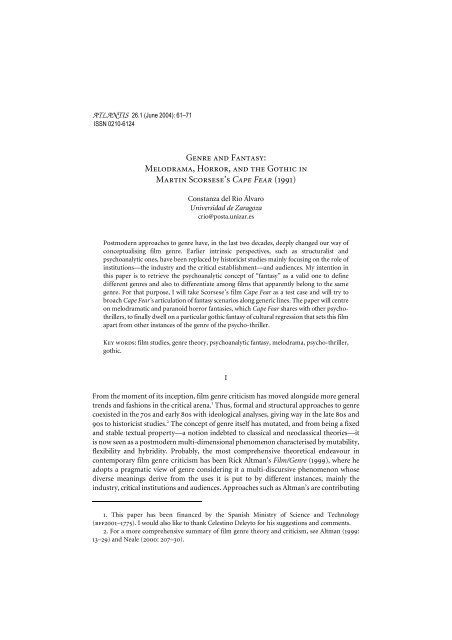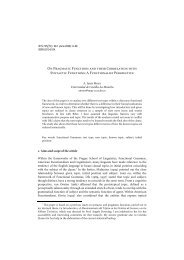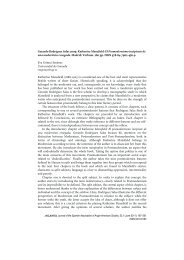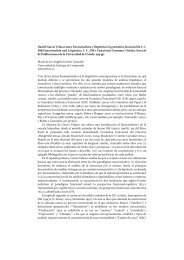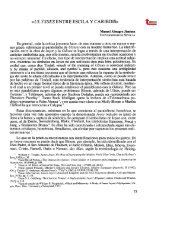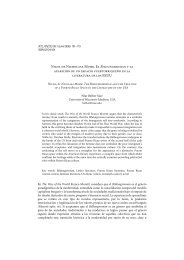Constanza del Río Álvaro - Atlantis
Constanza del Río Álvaro - Atlantis
Constanza del Río Álvaro - Atlantis
You also want an ePaper? Increase the reach of your titles
YUMPU automatically turns print PDFs into web optimized ePapers that Google loves.
ATLANTIS 26.1 (June 2004): 61–71<br />
ISSN 0210-6124<br />
Genre and Fantasy:<br />
Melodrama, Horror, and the Gothic in<br />
Martin Scorsese’s Cape Fear (1991)<br />
<strong>Constanza</strong> <strong>del</strong> <strong>Río</strong> <strong>Álvaro</strong><br />
Universidad de Zaragoza<br />
crio@posta.unizar.es<br />
Postmodern approaches to genre have, in the last two decades, deeply changed our way of<br />
conceptualising film genre. Earlier intrinsic perspectives, such as structuralist and<br />
psychoanalytic ones, have been replaced by historicist studies mainly focusing on the role of<br />
institutions—the industry and the critical establishment—and audiences. My intention in<br />
this paper is to retrieve the psychoanalytic concept of “fantasy” as a valid one to define<br />
different genres and also to differentiate among films that apparently belong to the same<br />
genre. For that purpose, I will take Scorsese’s film Cape Fear as a test case and will try to<br />
broach Cape Fear’s articulation of fantasy scenarios along generic lines. The paper will centre<br />
on melodramatic and paranoid horror fantasies, which Cape Fear shares with other psychothrillers,<br />
to finally dwell on a particular gothic fantasy of cultural regression that sets this film<br />
apart from other instances of the genre of the psycho-thriller.<br />
Key words: film studies, genre theory, psychoanalytic fantasy, melodrama, psycho-thriller,<br />
gothic.<br />
I<br />
From the moment of its inception, film genre criticism has moved alongside more general<br />
trends and fashions in the critical arena. 1 Thus, formal and structural approaches to genre<br />
coexisted in the 70s and early 80s with ideological analyses, giving way in the late 80s and<br />
90s to historicist studies. 2 The concept of genre itself has mutated, and from being a fixed<br />
and stable textual property—a notion indebted to classical and neoclassical theories—it<br />
is now seen as a postmodern multi-dimensional phenomenon characterised by mutability,<br />
flexibility and hybridity. Probably, the most comprehensive theoretical endeavour in<br />
contemporary film genre criticism has been Rick Altman’s Film/Genre (1999), where he<br />
adopts a pragmatic view of genre considering it a multi-discursive phenomenon whose<br />
diverse meanings derive from the uses it is put to by different instances, mainly the<br />
industry, critical institutions and audiences. Approaches such as Altman’s are contributing<br />
1. This paper has been financed by the Spanish Ministry of Science and Technology<br />
(bff2001–1775). I would also like to thank Celestino Deleyto for his suggestions and comments.<br />
2. For a more comprehensive summary of film genre theory and criticism, see Altman (1999:<br />
13–29) and Neale (2000: 207–30).
62 <strong>Constanza</strong> <strong>del</strong> <strong>Río</strong> <strong>Álvaro</strong><br />
to a rapid change in our way of thinking about film genre. Yet the sheer speed of these<br />
changes runs the risk of obliterating earlier perspectives that, while being equally<br />
productive, may not have been sufficiently explored and may not deserve to be summarily<br />
superseded. In my view, this is the case of psychoanalysis, which still remains central for<br />
the theorisation of film genres and for the analysis of individual genre texts. 3 My intention<br />
here is to take Scorsese’s Cape Fear as a test case to pursue a conception of genre that will<br />
take into account the psychoanalytic notion of “fantasy,” defined as a psychical register<br />
that represents the reality of the unconscious.<br />
In their seminal article “Fantasy and the Origins of Sexuality” (1968), Laplanche and<br />
Pontalis <strong>del</strong>ineated the concept of fantasy and gave it the function of structuring desire and<br />
sexuality, a function carried out through fantasy’s ability to stage a perceptual scenario in<br />
which the subject participates actively without being assigned any fixed position. In an<br />
article entitled “Fantasia” (1984), Elizabeth Cowie applied these arguments to the film text,<br />
considered as a form of public fantasy, and she advanced the interesting idea that<br />
conventions of representation are the means used to rework a private fantasy for public<br />
consumption. In her own words: “Conventions are thus the means by which the<br />
structuring of desire is represented in public forms, inasmuch as, following the arguments<br />
of Laplanche and Pontalis earlier, fantasy is the mise-en-scène of desire. What is necessary<br />
for any public forms of fantasy, for their collective consumption, is not universal objects<br />
of desire, but a setting of desiring in which we can find our place(s). And these places will<br />
devolve, as in the original fantasies, on positions of desire: active or passive, feminine or<br />
masculine, mother or son, father or daughter” (87).<br />
Cowie’s thesis allows for the reading of any film as psychoanalytic fantasy and for the<br />
fact that different genres, marked by different conventions, may accommodate particular<br />
types or structures of fantasy. Fantasy may then be seen as a defining generic component.<br />
Yet the function of fantasy may go further, since generic products trade on preserving a<br />
balance between repetition and variation of established formulae. In this sense, not only<br />
different genres, but also films belonging to the same genre could be differentiated<br />
according to the fantasies they activate from the existing repertoire. As I will show in what<br />
follows, Cape Fear activates typically melodramatic and paranoid horror fantasies, and in<br />
this respect, it is a fairly representative psycho-thriller. But if the film shares this generic<br />
identity with many other titles, I will also demostrate that it nevertheless has a distinctive<br />
atmosphere of fin de siècle cultural malaise that is unique. My contention will be that the<br />
specific fantasy scenarios that the film activates work to establish both generic connections<br />
and differences, and that it is a particular gothic fantasy of cultural regression that marks<br />
the film off from other examples of the psycho-thriller. In the case of Cape Fear, this<br />
variation factor, actualised through a gothic fantasy, can also be linked to the fact that this<br />
film has a peculiar status, since it is undoubtedly a commercial genre film but its director<br />
is an undisputed auteur who left his own authorial mark of distinctiveness on the text. In<br />
this sense, Scorsese’s choice of the gothic accords with one of his major preoccupations as<br />
film-maker: the exploration of the dark side of U. S. American life, myths and human<br />
behaviour.<br />
3. Mark in this respect the work carried out by Elsaesser (1972) and Nowell-Smith (1987) on the<br />
genre of melodrama, or by Clover (1992) and Creed (1993) on the horror film, just to mention some<br />
examples.
Genre and Fantasy 63<br />
Cape Fear was a big budget Spielberg production that represented Martin Scorsese’s<br />
entry into mainstream Hollywood. In it Scorsese updated John Lee Thompson’s noir<br />
B-thriller Cape Fear (1962), a film based on the novel by John D. MacDonald The<br />
Executioners (1957). As declared by Scorsese in different interviews, his aim behind the<br />
Cape Fear project—a commission rather than a personal endeavour—was double: to thank<br />
Universal Studios for backing the production of The Last Temptation of Christ (1988) 4 and<br />
to take up the challenge of dealing with the conventions of the thriller, a genre he loves, in<br />
order “to see whether it would look like everybody’s thriller or if I could give it something<br />
extra” (cit. Fuller 1991: 17). This second aim meant that Scorsese had to make the story his<br />
own and give it a distinct flavour in terms of treatment of themes and style. For that<br />
purpose, and with the help of scriptwriter Wesley Strick, he introduced moral tensions,<br />
replacing, for example, the sanitised version of the Bowden family featuring in Thompson’s<br />
Cape Fear by a more contemporary U. S. American nightmare: the dysfunctional family.<br />
He also gave the film his characteristic edgy visual style, further reinforcing the thematic<br />
and stylistic continuity expected from an auteur with the presence of his then “fetish”<br />
actor, Robert De Niro. Yet, in spite of Scorsese’s personal appropriation of the staple<br />
conventions of the thriller and of his updating of Thompson’s version, critics and reviewers<br />
were quick to note the film’s unstable status, hovering in between the commercial genre<br />
film and the auteur creation (see Travers 1991; Schatz 1993: 35; Hinson 1999; Ebert 2002).<br />
While in general terms the film was praised as an excellent thriller, many reviewers voiced<br />
their disappointment at its being a Scorsese film: more was to be expected from such a<br />
celebrated original creator than just a rehashing of conventional formulae. 5<br />
The focus that Scorsese gave to the story, emphasising the shattering effects on the<br />
Bowden family—a suburban middle-class affluent family—of a psychopath’s brutal<br />
invasion of their intimacy, links the film to a group of Hollywood products portraying<br />
criminal actions, structured around suspense and articulating postmodern cultural anxieties<br />
about sexuality, femininity, masculinity, parenthood and family life. Some of the most<br />
popular titles within this group could be Adrian Lyne’s Nine and a Half Weeks (1986) and<br />
Fatal Attraction (1987), John Schlesinger’s Pacific Heights (1990), Martin Scorsese’s Cape<br />
Fear (1991), Paul Verhoeven’s Basic Instinct (1992), Curtis Hanson’s The Hand that Rocks the<br />
Cradle (1992), Barbet Schroeder’s Single White Female (1992), Alan J. Pakula’s Consenting<br />
Adults (1992) and David Fincher’s Seven (1995). It was the tremendous commercial success<br />
of, and cultural and media controversy originated by Adrian Lyne’s films that ensured a<br />
steady stock of similar products in the early 1990s. Whether these films constitute a cycle,<br />
a sub-genre of the broader category “thriller” or an individual genre, has not been<br />
sufficiently theorised. 6 Yet, in spite of differences in definition and appreciation, most critics<br />
4. See the documentary The Making of Cape Fear (2001) in the Universal DVD.<br />
5. The film’s critical reception reproduces the characteristically modern incompatibility between<br />
the concept of the author and that of genre, while also pointing towards the problematic status of<br />
and place occupied by the cinematic author in commercial postclassical cinema, where, for some<br />
critics, the author has survived as a marketing strategy rather than a humanist concept (Wyatt 1994:<br />
61; Corrigan 1991: 106), or as a disembodied and fantasised position providing a site of pleasure and<br />
identification for audiences (Grant 2000).<br />
6. For two divergent views on the generic status of the psycho-thriller, see Luzón (2002) and<br />
Grant (1998).
64 <strong>Constanza</strong> <strong>del</strong> <strong>Río</strong> <strong>Álvaro</strong><br />
and reviewers usually invoke the thriller and the horror genres—mainly the branch of<br />
contemporary horror inaugurated by Hitchcock’s Psycho (1960), leading into the horror<br />
sub-genre of the “slasher” that emerged in the late 1970s with Carpenter’s Halloween<br />
(1978)—as the basic ones from which the psycho-thriller has developed. My argument is<br />
that these approaches tend to ignore the psycho-thriller’s indebtedness to melodrama.<br />
II<br />
One of the defining characteristics of these films is precisely their interest in exploring the<br />
dissatisfactions latent in the nuclear family and in dramatising culturally repressed<br />
psychosexual conflicts within this social institution, an interest which links them in an<br />
essential way to domestic melodrama. Consequently, Scorsese’s Cape Fear and other socalled<br />
psycho-thrillers seem to me to be better defined as a combination of melodramatic<br />
and horror scenarios than as a combination of thriller and horror, since the effects of<br />
suspense and the element of criminality provided by the thriller are equally central<br />
components of the horror genre. As a matter of fact, melodrama and horror are two genres<br />
that seem to have many points in common. Stage melodrama and the gothic novel, this<br />
latter being horror’s parent genre, emerged in the same historical period: the second half<br />
of the eighteenth century. Peter Brooks has argued that, in a period of profound social and<br />
moral changes resulting in the desacralisation of ethics, these genres dramatised the<br />
importance of signalling where the new realm of ethical meanings and values now resided.<br />
Both genres deal with similar subjects and are preoccupied with evil, yet the main<br />
difference would be that melodrama ultimately manages to expel evil from the world and<br />
make the new ethical imperatives legible and visible, something that the darker and much<br />
more uncertain world of the gothic does not fully achieve (1991: 63–64). In this sense, it<br />
seems quite pertinent that a contemporary genre preoccupied with the interplay between<br />
identity, sexuality and the family, such as the psycho-thriller, would modulate the relatively<br />
simplistic and Manichean stance of melodrama with the ambiguous position of horror in<br />
order to produce narratives that are more in keeping with the uncertainties that pervade<br />
our postmodern world.<br />
It is precisely Cape Fear’s double indebtedness to melodrama and horror—two genres<br />
characterised by spectacle and excess—that endows the film with a densely textured<br />
narrative in which cinematic language contributes symptomatically to the creation of a<br />
visceral atmosphere of claustrophobia and paranoia. The film uses staple horror techniques<br />
—subjective camera and significant use of off-screen space—together with unrealistic<br />
framing, editing and mise-en-scène choices. Some of these are unmotivated high- and lowangle<br />
shots, canted and skewed camera angles, obsessive zoom-ins and close-ups, extreme<br />
close-ups and detail shots, shock editing or shock cuts, and screen space suffused in blocks<br />
of red, green and yellow. With these stylistic devices Cape Fear manages to offer a general<br />
panorama of progressive degeneration and decline, to emphasise grotesque physicality and<br />
to transform the human body into a spectacle of grand guignol. In addition, the figure of<br />
psychopath Max Cady (Robert De Niro), in its apparent invulnerability, combination of<br />
superhuman/infrahuman qualities and punitive actions, recalls the psychopaths Michael<br />
Myers, Jason and Freddy Krueger, discussed by Carol Clover in her study of the slasher<br />
(1992).
Genre and Fantasy 65<br />
On the other hand, as is the case with melodrama’s expressive mise-en-scène, in Cape<br />
Fear, stylistic excess suggests excess of signification, also embodied in Cady’s spectacular<br />
tattooed body, extreme violence and superhuman nature. Excess in melodrama has been<br />
explained as a result of sexual repression and displacement (Elsaesser 1972; Nowell Smith<br />
1987). In Cape Fear, it is the highly sexualised figure of Cady that can be seen as the<br />
psychoanalytic projection of the culturally censored desires of all the members of the<br />
Bowden family, much in the same way as, for example, the drapes in Vincente Minnelli’s<br />
The Cobweb (1955) can be interpreted as a blank text on which the different characters<br />
inscribe and project their repressed desires.<br />
In the film, melodramatic fantasies, such as the Freudian family romance and the<br />
seduction fantasy, 7 are stereotypically inscribed through the female characters of Danny<br />
(Juliette Lewis) and Leigh (Jessica Lange). In fact, it could be said that Danny in the initial<br />
moments of the film, and her mother Leigh, after the only lovemaking scene with her<br />
husband later on, summon Cady from the past out of hostility against Sam (Nick Nolte)<br />
and out of their own sense of loss. Danny’s scene of invocation signals from the start the<br />
unstable ontological and temporal status of the story told in Cape Fear, that is, its fantasy<br />
nature. The oneiric credit sequence, which connects Danny narratively and visually to<br />
Cady, introduces the story as Danny’s flashback. This is a framing device that activates the<br />
narrative as Danny’s literary reminiscence, but is it a reminiscence of real past events or of<br />
imagined past events? In other words, could this story be the memory that, we are told,<br />
Danny has to write about for homework? And, since it is conjured up in her mind, is it real<br />
or fictional? This ambiguity parallels that of the primal fantasies, whose status hovers<br />
between that of being supposedly historical past occurrences and present imaginary reenactments<br />
of such occurrences. Danny’s words in this initial narrative frame—her<br />
reminiscence—mystify the past by presenting it as a golden age of innocent childhood.<br />
This is quite ironic, since the picture that the spectator is offered of the Bowden family<br />
even before Cady irrupts into their lives is far from idyllic. In this sense, Danny’s<br />
reminiscence may account for an ideal mo<strong>del</strong> of childhood and family life, as much<br />
cultural as private, which is forever lost or has never really existed.<br />
Leigh’s invocation of Cady takes place some time later, quite significantly after the only<br />
lovemaking scene between husband and wife in the whole film. The photographic negatives<br />
used to visualise their lovemaking, together with Leigh’s action of walking as if mesmerised<br />
to her boudoir while Sam sleeps soundly, connote lack in the Bowden’s married life and<br />
Leigh’s sexual dissatisfaction. The moment when she puts on red lipstick in front of the<br />
mirror suggests that she is unconsciously preparing herself for a more exciting encounter.<br />
7. I refer to these fantasies as melodramatic since they centre on the domestic sphere of<br />
childhood relationships and traumas linked to Oedipality. Laplanche and Pontalis described the<br />
seduction fantasy—summarised as “a father seduces a daughter”—as an original fantasy that<br />
attempts to provide a representation of the origin and upsurge of sexuality (1968: 11). On the other<br />
hand, Freud explained the family romance fantasy in his essay “Family Romances” (1909 [1908]).<br />
According to Freud, the child needs to separate himself from his earlier identification with his<br />
parents and to liberate himself from their authority. In this attempt he is helped by impulses of sexual<br />
rivalry and feelings of emotional disaffection resulting in the child’s fantasy of replacement of his<br />
parents by surrogate ones who appear to fulfil the child’s wishes in a more satisfactory way (1977:<br />
221–25).
66 <strong>Constanza</strong> <strong>del</strong> <strong>Río</strong> <strong>Álvaro</strong><br />
She walks to the window, looks through the blinds and is startled to see Cady, whom she<br />
has not met so far, nonchalantly sitting on the wall that bounds the Bowden’s property.<br />
Although the narrative naturalises Leigh’s bitterness and anger as deriving from Sam’s<br />
extramarital affairs, there is also the feeling in the film that what she really resents is the<br />
lack of excitement, the predictability, responsibility and routine of family life. In this sense,<br />
this scene stages her desire to walk on the wild side and her secret fantasy of adultery. The<br />
mise-en-scène, cinematography and editing of this scene recall, in their hallucinatory<br />
effects, the opening moments of the film: again we have the photographic negatives, the<br />
screen suffused in blocks of green and red, the emphasis on vision and subjectivity, and the<br />
atmosphere of phantasmagoria and instability created by the reflections of the fireworks.<br />
Danny’s and Leigh’s summoning scenes are represented in the text as symbolic<br />
moments of pure emotion and sensuality, as if the screen were offering the symptomatic<br />
reflection of the repressed wishes of the female protagonists. This is a style that can be<br />
related to the hysterical expressiveness of melodrama, in the same way as Danny’s and<br />
Leigh’s fantasies can also be said to pertain to this genre and to be fully grounded in the<br />
family. It could be said that, in general, family life, family relationships and their<br />
constraining influence on gender and sexuality appear as originating the sense of loss that<br />
each member of the Bowdens feels according to his/her respective position within the<br />
institution. Danny, for example, is the paradigmatic female teenager, troubled by her<br />
burgeoning sexuality, discontented with her parents’ childish treatment of her and sensitive<br />
to the undercurrents of hatred between Sam and Leigh. Danny’s bonds with her parents<br />
are fraught with uneasiness, and it appears that she feels so miserable as to want to punish<br />
them and replace them with more caring ones, parents that represent the irretrievable past<br />
idealised in her reminiscence: the Cuban maid Graciela and Cady.<br />
This Freudian family romance fantasy combines with Danny’s seduction fantasy in one<br />
of the most climactic and most celebrated moments of the film: the school drama theatre<br />
scene, where Danny’s desire is literally staged in a fairy tale setting. The two tales alluded<br />
to—“Hansen and Gretel” and “Little Red Riding Hood”—are cautionary tales, but this<br />
does not prevent Danny from feeling dangerously attracted towards the seductive Cady,<br />
who poses throughout the scene as a suave and understanding composite of bohemian,<br />
confessor, therapist and pederast, that is, as the perfect figure to fill in the sexual and<br />
affective gaps in Danny’s life. The style in this scene—and De Niro’s performance—departs<br />
from the edginess and histrionics of the rest of the film and appears controlled and<br />
intimate, matching De Niro’s ominously <strong>del</strong>icate approach to the girl so as not to frighten<br />
her. Yet tension builds up until the fairy tale scenario, with its conventional associations<br />
of childhood and innocence, is finally on the verge of becoming the site of a pornographic<br />
encounter.<br />
In Cape Fear, melodramatic fantasies interact with a paranoid horror fantasy articulating<br />
male desires and castration anxieties around a doppelgänger plot that presents Max Cady as<br />
the perverse mirror in which Sam sees himself. Contrasting with the symbolic world of pure<br />
connotation, emotion and sensuality that stylistically marks Danny’s and Leigh’s first contact<br />
with Cady, for Sam the psychopath has nothing of this unconscious aura but becomes an alltoo<br />
factual presence. What the doppelgänger dialectic usually dramatises is the<br />
interdependence between otherness and sameness, or perversion and normality, pointing to<br />
the fact that otherness does not lie beyond a remote boundary but close within, being<br />
constructed as otherness only through strategies of displacement. Thus, in Cape Fear
Genre and Fantasy 67<br />
perversion clearly irrupts from the fissures among the members of the family, fissures whose<br />
responsibility seems to lie mainly with Sam, since Cady embodies Sam’s perversion as a<br />
lawyer, a father and a husband. What is unsettling about Cady is precisely the fact that his<br />
attacks on the Bowdens are made possible because of Sam’s own violation of moral, legal and<br />
social codes: he has subverted legal procedures, has been—and without Cady’s intervention<br />
would probably again be—unfaithful to his wife and is disturbed by his daughter’s sexuality.<br />
Cady, then, does not actually signify an alien threat, the threat of the absolute “other” or<br />
absolute difference, but a much more disturbing menace that discloses the inherent<br />
weaknesses and deficiencies of the institution of the family and of the legal system. The<br />
conclusion to be drawn is that the foundations on which society has been built are only too<br />
weak and vulnerable, that individual pleasures are frequently at odds with social demands and<br />
that morality—or equity—and legality do no always walk hand in hand. In this respect, while<br />
the viewer may consider that Sam’s decision to hide some evidence that could have<br />
exonerated Cady is ethically justified, the decision itself is undoubtedly illegal.<br />
The scene that best conveys the fluidity that characterises the subject’s position in a<br />
fantasy scenario, as well as the doppelgänger dialectic, is the full body strip-search scene.<br />
This is a scene in which the instincts at play are mainly scopophilia (pleasure in looking)<br />
and exhibitionism (pleasure in being looked at), with Cady apparently placed in the<br />
exhibitionistic, passive and feminine position. However, by the end of the scene Cady will<br />
have managed to turn the tables and be in total control of the situation. The sense of<br />
fluidity and disorientation at the respective spatial positions occupied by the different<br />
participants in the scene, that is, the collapse of demarcating lines between outside/inside,<br />
activity/passivity, scopophilia/exhibitionism and masculinity/femininity, is visually<br />
articulated “by the use of circular tracking shots and two-way mirrors, which make it<br />
nearly impossible to discern at any given moment who is looking at whom and whose<br />
point of view the spectator is being given” (Stoddart 1995: 198). Furthermore, by locating<br />
this crucial confusing moment inside a police station, the boundary between law and<br />
criminality also dissolves.<br />
To the melodramatic and paranoid horror components discussed so far, Cape Fear adds<br />
the activation of a peculiar gothic fantasy of regression to a primordial condition prior to<br />
civilisation, a fantasy that is absent from other examples of the psycho-thriller.<br />
III<br />
As discussed above, the film shows the weaknesses inherent in the institution of the nuclear<br />
family and parodies the legal system by appropriating it from within and by transforming<br />
it into mere farce in the final “horror-trial” in the boathouse. 8 Yet Cape Fear extends its<br />
critique to another fundamental pillar of Western societies: religion. There are in Cape Fear<br />
8. Cape Fear’s subversion of the legal system is reinforced by the intertextual game implied in<br />
Scorsese’s casting. Robert Mitchum, who had played the psychopath Cady in Thompson’s Cape Fear,<br />
appears here as police officer Elgart, while Gregory Peck, a thoroughly upright Sam Bowden in the<br />
original version, is cast in the role of murky attorney Lee Heller, a role that also contrasts with Peck’s<br />
Oscar-winning performance as the high-principled Atticus Finch in Robert Mulligan’s To Kill a<br />
Mockingbird (1962).
68 <strong>Constanza</strong> <strong>del</strong> <strong>Río</strong> <strong>Álvaro</strong><br />
recurrent biblical allusions and iconography, but the film’s religious discourse as upheld<br />
by Cady is thoroughly sexualised and transformed into an eroticised surface, pure<br />
performance and spectacle. Yet, as was the case with the legal system, this subversion of<br />
religion would not be possible if religion itself did not provide the conditions for its own<br />
transgression. Cady’s perversion of familial, legal and religious discourses, as well as his<br />
gradual transformation into a monstrous, indestructible, superhuman figure, give the film<br />
a fin de siècle atmosphere that ultimately signifies not only the fragility of the institution<br />
of the family but of the whole of Western culture.<br />
One of the underlying themes of the film is that civilisation is a thin, flimsy veneer. The<br />
topic is introduced through a running discourse on the <strong>del</strong>imitation between humanity and<br />
lack of humanity, or civilisation and barbarism, and is fully staged in the final ordeal at the<br />
boathouse. In this sense the film can be seen as mapping a collective fantasy, a cultural fantasy<br />
in which in order to expel the savage and the animal, in order to become a civilised and<br />
socialised human being, one has paradoxically to lapse into savagery. 9 This lapsarian fantasy<br />
of regression to a primordial condition—visualised in the elemental waters and swamp of the<br />
final scenes of the film—pertains to the horror genre, but more specifically to the pre-history<br />
of the contemporary horror film: the literary tradition of the gothic. In this respect, it may be<br />
worth mentioning that for Scorsese himself the general atmosphere of Cape Fear had to be<br />
gothic, and he ensured that cinematographer Freddie Francis gave the film the feeling of<br />
degradation and claustrophobia of a gothic thriller (Morgan 1991: 34).<br />
In his Introduction to The Oxford Book of Gothic Tales, Chris Baldick provided a<br />
definition of the gothic, which, I think, captures the essentials of the different historical<br />
manifestations of the genre. For Baldick, the gothic effect is achieved through the<br />
combination of “a fearful sense of inheritance in time with a claustrophobic sense of<br />
enclosure in space” (1992: xix). As can be seen, the crucial gothic elements are the<br />
treatment of space and the dialectic past/present, according to which an archaic and<br />
despotic past haunts and visits the present. In spite of Cape Fear’s being Scorsese’s first<br />
widescreen film, the atmosphere of confinement and claustrophobia is forever present, and<br />
not only in the scenes shot inside the home and the boathouse. The sense of entrapment<br />
derives rather from the handling of the whole of the screen, a surface often taken up by<br />
intense close-ups that leave no breathing space. As for the dialectic past/present, David<br />
Punter has briefly discussed Cape Fear as a gothic national parable offering a version of<br />
U. S. American history. Punter mentions the speech on fear uttered in the film by detective<br />
Kersek (Joe Don Baker) equating the family’s “barbaric” decision to set a trap on Cady, out<br />
of their own impotence and terror, with the foundation of the U. S. American South out<br />
of fear of the Indians, the slaves and the Union (1996: 153–55). For Punter, this is the<br />
despotic and violent past that haunts the present, much in the same way as the sins of the<br />
father, Sam, are visited upon his children, and this “fearful sense of inheritance in time”<br />
is a staple gothic motif. Max Cady is the contemporary gothic villain, a psychopath that<br />
comes from the past to remind contemporary U. S. Southerners that, however hard they<br />
may try, they cannot extricate themselves from the very violence that founded their nation.<br />
9. The lapse of the civilised man into savagery in order to cope with the threat of the barbaric is<br />
a conventional motif in the western, a genre that explores a specific dimension of the U. S. American<br />
myth of (national) origins.
Genre and Fantasy 69<br />
Without disregarding the film’s allusions to U. S. American history—let us not forget<br />
that the events coincide quite significantly with the celebration of Independence Day—I<br />
would argue that there is an even more archaic event encoded in the final scenes of the<br />
film, where setting, lighting and natural elements conflate to recall a primordial past<br />
previous to history. In the film’s violent denouement, Sam is forced to revert to the<br />
position of a savage—again fantasy’s fluidity and permutation of positions—intent on<br />
stoning his opponent to death. The act of killing Cady is meant to eradicate the inhuman,<br />
the animal, the barbaric, and to re-set the boundaries of the civilised. This scenario recalls<br />
the Ur-fantasy speculated upon by Freud in “Totem and Taboo” (1985 [1913]), an essay in<br />
which Freud tried to provide an anthropological-mythical explanation for the origins of<br />
religion and morality. For Freud, the foundational act of civilisation would be the sons’<br />
killing of the hated and loved violent primal father, a killing which results in the<br />
establishment of two taboos through the sense of guilt: not to kill the father (or brothers)<br />
again and not to possess the mother (or sisters). Paradoxically, it is an act of violent<br />
aggression—parricide—that inaugurates civilisation and the Law. Terry Eagleton has<br />
elaborated on the consequences of this paradox, arguing that this primordial violent act<br />
reveals the lawlessness of the law and empties it of any constitutional or consensual value.<br />
The only function of the law would then be to conceal its own criminal inception, and it<br />
is this attempt that renders legality anarchically coercive and tautological: it only answers<br />
to its own authority (1995: 43–46). However, the initial outrage cannot be forgotten, “but<br />
will persist as a repressed traumatic kernel, since to eradicate this would be to abolish the<br />
condition of legality as such” (46). Cape Fear re-enacts this “repressed traumatic kernel”<br />
in an attempt to, once again, police the boundaries between lawlessness and legality, or<br />
barbarism and civilisation. After this foundational act has been performed, the fantasy can<br />
again be pushed back to the archaeology of humanity. Yet, as a true gothic text, Cape Fear<br />
signals the fragility of the demarcations, stemming from the fragility of the law itself, while<br />
it also points to the permanent but necessary threat that the return of the archaic past<br />
represents.<br />
At the end of the film, Sam has cleansed his hands of sin and guilt and the Bowdens<br />
have survived, yet the image of the family shivering and huddling together, covered in<br />
mud, does not reassure the viewer that their future will be one of happiness and stability.<br />
The Bowdens will have to live with the knowledge of their own vulnerability and of the<br />
deficiencies inherent in private and public institutions. Danny’s framing discourse closes<br />
the narrative with the intimation that Cady and what he represents will not be wiped out,<br />
thus leaving the spectator with the disturbing feeling that transgression unavoidably<br />
inhabits our psyches and our world. This is quite understandable, for the staple gothic<br />
motif of the double signifies the “unnegotiable divide between the true and natural self and<br />
society, between nature and culture” (Edmundson 1997: 10).<br />
IV<br />
To conclude, in this paper I have approached Cape Fear as a psycho-thriller that articulates<br />
melodramatic and paranoid horror conventions and scenarios, structuring them around<br />
a suspenseful thriller narrative. I have considered the different psychic fantasies encoded<br />
in Cape Fear, linking them to the genres they characteristically are associated with. What
70 <strong>Constanza</strong> <strong>del</strong> <strong>Río</strong> <strong>Álvaro</strong><br />
derives from such an analysis is that the most important narrative and symbolic function<br />
fulfilled by this combination of melodramatic and paranoid horror motifs, conventions<br />
and fantasies, is that of conflating the feminine with the masculine, the private—domestic<br />
and family life—with the public—the legal system. The interaction of melodrama and<br />
horror serves to amplify and expand meanings into ever-widening circles, a process which<br />
in the case of Cape Fear extends beyond the scope of other psycho-thrillers in order to<br />
include a critique to the foundations of Western civilisation. Furthermore, the interaction<br />
of horror and gothic fantasies with melodramatic ones approximates the film to the mode<br />
of uncertainty and disillusionment that characterises our times.<br />
The fact that the distinctiveness of Scorsese’s film results from the activation of a<br />
specific apocalyptic gothic fantasy has shown that the psychoanalytic concept of fantasy<br />
is a valid one in determining both the general anxieties that underlie the psycho-thriller<br />
and the components that differentiate this film from, let us say, Pacific Heights or The Hand<br />
that Rocks the Cradle. Further research along these lines could be fruitful as well in<br />
establishing connections and differentiations among other genres and among texts<br />
belonging to the same genre. Such a perspective would still be interested in individual<br />
textual features but would avoid a fixed and essentialist notion of genre, since genre would<br />
be seen as a hybrid and flexible category, open to varied permutations and unexpected<br />
combinations according to the kind of fantasies inscribed in each text.<br />
Works Cited<br />
Altman, Rick 1999: Film/Genre. London: BFI.<br />
Baldick, Chris, ed. 1992: Introduction. The Oxford Book of Gothic Tales. Oxford and New York:<br />
Oxford UP. xi–xxiii.<br />
Brooks, Peter 1991 (1985): “The Melodramatic Imagination.” Imitations of Life: A Reader on Film and<br />
Television Melodrama. Ed. Marcia Landy. Detroit: Wayne State UP. 50–67.<br />
Cape Fear 2001 (1991): Universal DVD. Actors: Robert De Niro, Nick Nolte, Jessica Lange, Joe Don<br />
Baker, Juliette Lewis, Robert Mitchum and Gregory Peck. Bernard Herrmann score adapted by<br />
Elmer Bernstein. Edited by Thelma Schoonmaker. Photography by Freddie Francis. Screenplay<br />
by Wesley Strick. Produced by Barbara de Fina. Directed by Martin Scorsese.<br />
Clover, Carol 1992: Men, Women, and Chain Saws: Gender in the Modern Horror Film. Princeton:<br />
Princeton UP.<br />
Corrigan, Timothy 1991: “The Commerce of Auteurism: Coppola, Kluge, Ruiz.” A Cinema without<br />
Walls: Movies and Culture After Vietnam. New Brunswick: Rutgers UP. 101–36.<br />
Cowie, Elizabeth 1984: “Fantasia.” M/F 9: 70–105.<br />
Creed, Barbara 1993: The Monstrous Feminine: Film, Feminism, Psychoanalysis. London and New<br />
York: Routledge.<br />
Eagleton, Terry 1995: Heathcliff and the Great Hunger: Studies in Irish Culture. London and New<br />
York: Verso.<br />
Ebert, Roger 2002: “Cape Fear.” Rev. of Cape Fear, by Martin Scorsese. On line at http://<br />
www.suntimes.com.<br />
Edmundson, Mark 1997: Nightmare on Main Street: Angels, Sadomasochism and the Culture of Gothic.<br />
Cambridge: Harvard UP.<br />
Elsaesser, Thomas 1972: “Tales of Sound and Fury: Observations on the Family Melodrama.”<br />
Monogram 4: 2–15.<br />
Freud, Sigmund 1977 (1909 [1908]): “Family Romances.” On Sexuality. Ed. Angela Richards.<br />
Harmondsworth: Penguin. 221–25.
Genre and Fantasy 71<br />
——— 1985 [1913]: “Totem and Taboo: Some Points of Agreement between the Mental Lives of<br />
Savages and Neurotics.” The Origins of Religion. Harmondsworth: Penguin. 53–224.<br />
Fuller, Graham 1991: “Martin Scorsese.” Interview 21.2: 16–19.<br />
Grant, Barry Keith 1998: “Rich and Strange: The Yuppie Horror Film.” Contemporary Hollywood<br />
Cinema. Ed. Steve Neale and Murray Smith. London and New York: Routledge. 280–93.<br />
Grant, Katherine 2000: “www.auteur.com?” Screen 41.1: 101–08.<br />
Hinson, Hal 1999: “Cape Fear.” Rev. of Cape Fear, by Martin Scorsese. On line at http://www.<br />
washingtonpost.com.<br />
Laplanche, Jean, and J.-B. Pontalis 1968: “Fantasy and the Origins of Sexuality.” The International<br />
Journal of Psycho-Analysis 49.1: 1–18.<br />
Luzón, Vicky 2002: “Film Genre and its Vicissitudes: The Case of the Psychothriller.” <strong>Atlantis</strong> 24.1:<br />
163–72.<br />
Morgan, David 1991: “A Remake that Can’t Miss: Cape Fear.” American Cinematographer 72.10:<br />
34–40.<br />
Neale, Steve 2000: Genre and Hollywood. London and New York: Routledge.<br />
Nowell-Smith, Geoffrey 1987: “Minnelli and Melodrama.” Home Is Where the Heart Is: Studies in<br />
Melodrama and the Woman’s Film. Ed. Christine Gledhill. London: BFI. 70–74.<br />
Punter, David 1996: The Modern Gothic. Vol. 2 of The Literature of Terror. 2 vols. London and New<br />
York: Longman.<br />
Schatz, Thomas 1993: “The New Hollywood.” Film Theory Goes to the Movies. Ed. Jim Collins, Hilary<br />
Radner and Ava Preacher Collins. New York and London: Routledge. 8–36.<br />
Stoddart, Helen 1995: “‘I Don’t Know Whether to Look at Him Or Read Him’: Cape Fear and Male<br />
Scarification.” Me Jane: Masculinity, Movies, and Women. Ed. Pat Kirkham and Janet Thumin.<br />
London: Lawrence and Wishart. 194–202.<br />
Travers, Peter 1991: “Cape Fear.” Rev. of Cape Fear, by Martin Scorsese. On line at http://www.<br />
rollingstone.com.<br />
Wyatt, Justin 1994: High Concept: Movies and Marketing in Hollywood. Austin: U of Texas P.


